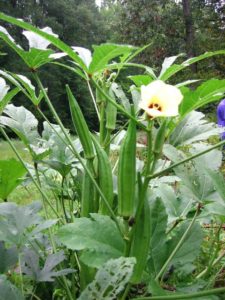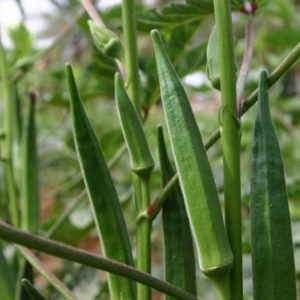Introduction of Ladies finger: – Ladies finger of Okra, which is also known as ‘Bhindi’, is one of the important vegetable crops of India. It is grown throughout the tropical and sub tropical regions and also in the warmer parts of the temperate regions. Okra or Ladies finger (Abelmoschus esculentum(L) Moench) plant belongs to the family Malvaceae. The nutritional value of 100g of edible okra is characterized 1.9 g protein, 0.2 g fat, 6.4 g carbohydrate, 0.7 g minerals and 1.2 g fibers. Okra or Ladies Finger has a good potential as a foreign exchange crop and accounts for 65% of the export of fresh vegetables. It is cultivated in 0.35 M ha area with the production of 3.5 m and productivity of 9.6 m/ha. The major Ladies finger/Okra producing states in India are Uttar Pradesh, Bihar, Orissa, West Bengal, Andhra Pradesh and Karnataka.
Improved varieties of Ladies finger: – The crop varieties are Kamini, Pusa Mukhamali, Parbhani Kranti, Pusa Sawani, Vaihali, Vagmi, Padmini etc. are commonly cultivated ladies finger varieties.
Local names for Ladies Finger: Ladies finger, Okra (English), Bhindi (Hindi), Belendri (Manipur), Vendaikkaai (Tamil), Bendakaya in (Telugu), Vendakka (Malayalam), Bende kaayi (Kannada), Bhinda/Bhunda (Gujarati), Dherasa (Baengali), Bindu (Kashmiri), Bhendi (Marati, Oriya).
Climatic condition required for Ladies Finger Farming: – Ladies finger requires long warm growing season during its growing period. It gives good yield in warm humid condition. It grows best within a temperature range of 22-35ᵒ C. It can be successfully grown in rainy season even in heavy rainfall are. Bhendi is highly susceptible to frost injury. Seeds fail to germinate when temperature is below 20ᵒC.
Suitable soil for ladies finger farming: – Ladies finger or Bhendi can be grown well in all kinds of soil. But sandy loam and clay-loam soils are best for its cultivation. The optimum ph range is between 6 and 6.8. Soils with high organic matter are preferred so that cartloads of FYM or compost should be incorporated during land preparation. Soil should have good internal drainage.
Land preparation in Ladies finger farming: – The land should be well prepared with 2-3 ploughing. Well decomposed FYM (25 t/ha) is incorporated at the time of land preparation. Bhendi is sown on ridges or on flat soil. If soil is heavy, sowing should be done on ridges. Application of organic manure like neem cake and poultry manures improves the plant growth and the yield in this crop. It is possible to reduce the use fertilizer by using neem cake and poultry manures of any other compost.
Soil sterilization in Ladies finger farming: – The sterilization of the soil can be achieved by both physical and chemical means. Physical control measures include treatments with steam and solar energy. Chemical control methods include treatments with herbicides and fumigants. Soils sterilization can be achieved by using transparent plastic mulch film, which is termed as soil solariztion. During soil solarization, the incoming solar radiation penetrates the transparent plastic film and is absorbed in the soil. The absorbed radiation converts into heat energy, which raises the soil temperature and kills many soil borne organisms including plant pathogens and pests.
Seed Rate & Sowing time: – Seed rate of Ladies finger is about 3.5-5.5 kg seeds/ha during summer seasons and 8-10 kg seeds/ha for rainy season crop. The seed rate generally varies with germination percentage, spacing and season. Before sowing the seeds are soaked in a solution of Bavistin (0.2%) for 6 hours. The seeds are than dried in shade. The seeds are dibbled on the either side of the furrows at a spacing of 60 X 30 cm in kharif season and 30 X 30 cm in summer season.
Best season for ladies finger farming: – The optimum time of seed sowing varies greatly depending upon climate, varieties and their temperature requirement for growth. Normally the crop is sown between January-March and June-August. The exact month of sowing depends on the region.
Spacing in Ladies finger farming: – Ridges & furrow type of layout is use. The hybrid varieties are planted at a spacing of 75 X 30 cm or 60 X 45 cm. A presoaking irrigation 3-4 days before sowing is beneficial. The seeds germinate in about 4-5 days.
Dip system requirement in Ladies finger farming: Area: 1 ha, planting geometry: 60cm X 30cm Variable Items: 75 mm F PVC/HDPE pipe-54m, 75mm F PVC/HDPE pipe-102m, 12mm F LDPE Lateral-8400m, Online dripper (2 l/h) -13,888 Nos., control valve – 2 Nos., Tees/bends-1 No., Accessories. Fixed Items: Screen Filter (15m 3/h) -1 No., Bypass assembly: 1 No., Fertilizer applicator – 1 No., Accessories.
Irrigation/Water supply in Ladies finger farming: – The bhendi crop requires adequate moisture in the soil during summer months for faster growth. Drip irrigation is most suitable to the ladies finger crop as it provides uniform moisture throughout the season. The daily water requirement of ladies finger crop is 2.4 l/day/4 plants during early growth stage and 7.6 l/day/4 plants during the peak growth stage. The irrigation system should be operated daily for 75 minutes during initial growth stage and for 228 minutes during peak growth of the crop with an emitter capacity of 2 lph. Water supply on each day or on alternate days with On-line type of drippers is preferred.
Application of manures and fertilizers in Ladies finger farming: – In order to maximize the yield about 30 t of FYM 35 kg super phosphate, 125 kg Murate of Potash and 300 kg Ammonium sulphate should be applied through fustigation in three split doses.
 Weed control in Ladies finger farming: – As bhendi is harvested over a long period, weed control happens to be an important cultural operation. Weeding, thinning and earthling up is the important intercultural operations of bhendi. Earthing up in the rows should be done in rainy season crop. Application of herbicides for controlling weeds in bhendi is fond effective. Basalin (Fluchoralin 48 percent) @ 1-2 liter per hectare, and soil application of Tok-E-25 @ 5 liter per hectare effectively controlled the weeds. Shallow rooted inter-row cultivation and hand weeding may be used to minimize weeds in the inter row zone. Black plastic mulch may be used to suppress weed growth. The black plastic mulch also keeps the soil warm and encourages plant growth.
Weed control in Ladies finger farming: – As bhendi is harvested over a long period, weed control happens to be an important cultural operation. Weeding, thinning and earthling up is the important intercultural operations of bhendi. Earthing up in the rows should be done in rainy season crop. Application of herbicides for controlling weeds in bhendi is fond effective. Basalin (Fluchoralin 48 percent) @ 1-2 liter per hectare, and soil application of Tok-E-25 @ 5 liter per hectare effectively controlled the weeds. Shallow rooted inter-row cultivation and hand weeding may be used to minimize weeds in the inter row zone. Black plastic mulch may be used to suppress weed growth. The black plastic mulch also keeps the soil warm and encourages plant growth.
Pests and Diseases in Ladies finger Farming: – The control measures for insects, pests and disease depend upon type and intensity of the problem. The control measures for the main pests and diseases in Ladies finger farming are stated below.
Flea beetles are the major insect for Bhendi/Okra. This can be controlled with row covers or applications of Rotenone or Pyrethrum. Bhendi is susceptible to diseases such as Verticillium, Fusarium and Several
Other fungal diseases in wet season. These diseases can be controlled by proper crop rotation and good garden sanitation practices in Ladies Finger farming.
Harvesting of Ladies finger: – Flowering begins from 35 to 40 days after sowing. Crop is harvested in 55 to 65 days after planting when pods are 2 to 3 inches long. At this stage the pods area still tender. Larger okra pods will tend to be tough and fibrous. Round padded okra varieties remain tender at larger pod sizes and are good to use for slicing and freezing. Since, Okra grows very fast; it should be harvested every two days. The pods should not be allowed to mature on the plant because this will inhibit more pods from developing and reduce the productivity of the plant. Handling of okra should be done carefully because the pods bruise easily.
Ladyfinger
Copyright © 2024
